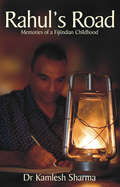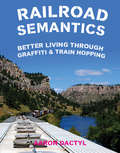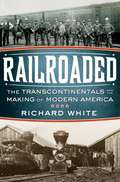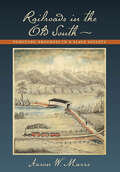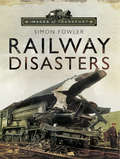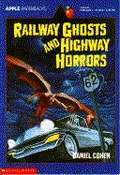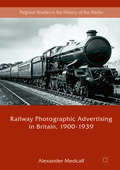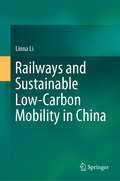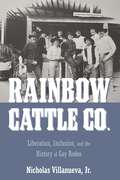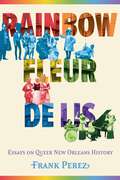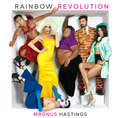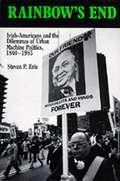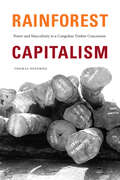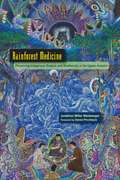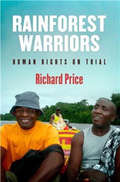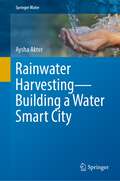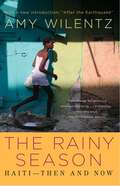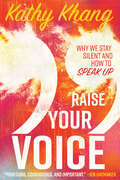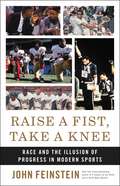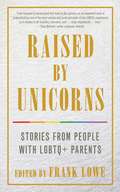- Table View
- List View
Rahul’s Road: Memories of a Fijiindian Childhood
by Dr Kamlesh SharmaRahul's Road is a story of childhood in a Fijiindian village, Korovuto in Nadi on the largest island of the Fijian archipelago in the South Pacific. It presents a rich tapestry of the details of what it was like to grow up in a poor Fijiindian family. It captures moments of growing-up in Fiji with vividness and sensitivity. Written with feeling, the author's language has a simplicity that is quite remarkable in its richness and associations. The story told is complex, moving and vividly narrated. Rahul's Road will echo in the mind and memory of many Fijiindians within and outside their place of birth. It is a book for children, adolescents, adults who care about Fiji and the struggles and strengths of a migrant community. It cuts across barriers and builds bridges of memory, remembrance and understanding.
Raiders and Rebels: A History of the Golden Age of Piracy
by Frank SherryI he most authoritative history of piracy, Frank Sherry's rich and colorful account reveals the rise and fall of the real "raiders and rebels" who terrorized the seas. From 1692 to 1725 pirates sailed the oceans of the world, plundering ships laden with the riches of India, Africa, South America, and the Caribbean. Often portrayed as larger-than-life characters, these outlaw figures and their bloodthirsty exploits have long been immortalized in fiction and film. But beneath the legends is the true story of these brigands—often common men and women escaping the social and economic restrictions of 18th-century Europe and America. Their activities threatened the beginnings of world trade and jeopardized the security of empires. And together, the author argues, they fashioned a surprisingly democratic society powerful enough to defy the world.
Raiding the Land of the Foreigners: The Limits of the Nation on an Indonesian Frontier
by Danilyn RutherfordWhat are the limits of national belonging? Focusing on Biak--a set of islands off the coast of western New Guinea, in the Indonesian province of Irian Jaya--Danilyn Rutherford's analysis calls for a rethinking of the nature of national identity. With the resurgence of separatism in the province, Irian Jaya has become the focus of fears that the Indonesian nation is falling apart. Yet in the early 1990s, the fieldwork for this book was made possible by the government's belief that Biaks were finally beginning to see themselves as Indonesians. Taking in the dynamics of Biak social life and the islands' long history of millennial unrest, Rutherford shows how practices that indicated Biaks' submission to national authority actually reproduced antinational understandings of space, time, and self. Approaching the foreign as a focus of longing in cultural arenas ranging from kinship to Christianity, Biaks participated in Indonesian national institutions without accepting the identities they promoted. Their remarkable response to the Indonesian government (and earlier polities laying claim to western New Guinea) suggests the limits of national identity and modernity, writ large. This is one of the few books reporting on the volatile province of Irian Jaya. It offers a new way of thinking about the nation and its limits--one that moves beyond the conventions of both scholarship and recent journalism. It shows how people can "belong" to a nation yet maintain commitments that fall both short of and beyond the nation state.
Rail Transit Station Area Development: Small Area Modeling in Washington DC
by Richard T Green David M. JamesA study of past and prospective business development around rail transit stations in the Washington DC area. Washington has one of the very few new and extensive rail transit systems in America, although expectations of transit system-induced revitalization in this area have not uniformly been met. This book develops an econometric model of local development (LOCDEV) around major public investments, applies it to the existing Washington transit system, and uses it to forecast future development levels around new stations. The book includes a user's guide to the LOCDEV model and concludes with reflections on modelling and forecasting.
Railroad Semantics: Better Living Through Graffiti & Train Hopping
by Aaron DactylDevoted to train-hopping, graffiti, and railroad culture, Aaron Dactyl's Railroad Semantics series describes the sights, sounds, successes, and defeats of exploring the western U.S. by freight train. The first four Railroad Semantics books are collected here for the first time. In their pages, you'll see epic, hidden works of art, read up on rail lore and riding tips, meet rail workers and fellow adventurers, and experience the perils and glories of life in rail yards, train cars, small towns, and encampments.
Railroaded: The Transcontinentals and the Making of Modern America
by Richard WhiteThe idea that railroads remade North America and in doing so created the modern corporate world is hardly new. Modern scholars have proclaimed it repeatedly, and in this they only follow the nineteenth-century intellectuals and promoters whom they cite.
Railroads in the Old South: Pursuing Progress in a Slave Society
by Aaron W. MarrsAaron W. Marrs challenges the accepted understanding of economic and industrial growth in antebellum America with this original study of the history of the railroad in the Old South. Drawing from both familiar and overlooked sources, such as the personal diaries of Southern travelers, papers and letters from civil engineers, corporate records, and contemporary newspaper accounts, Marrs skillfully expands on the conventional business histories that have characterized scholarship in this field. He situates railroads in the fullness of antebellum life, examining how slavery, technology, labor, social convention, and the environment shaped their evolution. Far from seeing the Old South as backward and premodern, Marrs finds evidence of urban life, industry, and entrepreneurship throughout the region. But these signs of progress existed alongside efforts to preserve traditional ways of life. Railroads exemplified Southerners' pursuit of progress on their own terms: developing modern transportation while retaining a conservative social order.Railroads in the Old South demonstrates that a simple approach to the Old South fails to do justice to its complexity and contradictions.
Railroads in the Old South: Pursuing Progress in a Slave Society
by Aaron W. MarrsAn original history of the railroad in the Old South that challenges the accepted understanding of economic and industrial growth in antebellum America.Drawing from both familiar and overlooked sources, such as the personal diaries of Southern travelers, papers and letters from civil engineers, corporate records, and contemporary newspaper accounts, Aaron W. Marrs skillfully expands on the conventional business histories that have characterized scholarship in this field. He situates railroads in the fullness of antebellum life, examining how slavery, technology, labor, social convention, and the environment shaped their evolution.Far from seeing the Old South as backward and premodern, Marrs finds evidence of urban life, industry, and entrepreneurship throughout the region. But these signs of progress existed alongside efforts to preserve traditional ways of life. Railroads exemplified Southerners’ pursuit of progress on their own terms: developing modern transportation while retaining a conservative social order.Railroads in the Old South demonstrates that a simple approach to the Old South fails to do justice to its complexity and contradictions.“The time is right to bring the South into the story of the economic transformation of antebellum America. Aaron Marrs does this with force and grace in Railroads in the Old South.” —John L. Larson, Purdue University“I am hard pressed to think of another volume that better catches the overall effect railroads had on the Old South.” —Kenneth W. Noe, Auburn University“Interesting regional history . . . It is a thoughtful and instructive study that examines not only the pervasiveness of transportation but also some of the social, political, and economic consequences associated with the evolution of southern railroads.” —Choice
Railway Disasters: Railway Disasters (Images of Transport)
by Simon FowlerBritish railways are one of the safest ways of travelling. That they are so is the result of painful lessons learnt over many decades, for there have been many hundreds of railway disasters.This book looks at some of the most famous as well as some that have been all but forgotten, matching graphic illustrations with eyewitness accounts of people who were there and the confidential reports of the accident investigators who worked out what had gone wrong.The book explores the reasons why accidents happen. Some are due to the carelessness of staff, others due to equipment failure or poor signalling. Yet others still baffle the experts. Simon Fowler is a long-standing Pen & Sword author having written many books on family and military history. He is a also a professional researcher and tutor.
Railway Ghosts and Highway Horrors
by Daniel CohenFrom the Book jacket: Feel like taking a little late night journey? Beware! Those eerie shadows along the road and bloodcurdling cries in the dark might be more than figments of your imagination. Ghastly tales of railway ghosts and highway horrors are infamous. Have you heard of the headless brakeman who warns of approaching danger on the railway, or the screaming, faceless phantoms who strike terror along the roadways? These and other spine-chilling stories are based on actual reports that will spook even nonbelievers. Are they in fact true? Do such supernatural beings exist? Only you can decide. RL 5
Railway Photographic Advertising in Britain, 1900-1939 (Palgrave Studies in the History of the Media)
by Alexander MedcalfThis book explores the phenomenal resources dedicated to understanding and encouraging passengers to consume travel from 1900 to 1939, analysing how place and travel were presented for sale. Using the Great Western Railway as a chief case study, as well as a range of its competitors both on and off the rails, Alexander Medcalf unravels the complex and ever-changing processes behind corporate sales communications. This volume analyses exactly how the company pictured passengers in the countryside, at the seaside, in the urban landscape and in the company’s vehicles. This thematic approach brings transport and business history thoroughly in line with tourism and leisure history as well as studies in visual culture.
Railways and Sustainable Low-Carbon Mobility in China
by Linna LiThis book explores the role of railways in developing sustainable low-carbon mobility by analyzing the intermodal relationship between railways and other transport modes. Focusing on geographical and governance perspectives, and taking China as a case study, it analyzes the competition and cooperation between and integration of railways and other transport modes, in order to provide guidance on future sustainable transport development. Firstly, the book examines the contribution of railways to low carbon emissions in China over recent decades by estimating the carbon dioxide emissions from various transport modes in China at national and regional levels using decomposition analysis. It then discusses the current competition and cooperation between railways and other transport modes, as well as their integration and the impact of their relationship on climate change. It also highlights how the competition between railways and other transport modes may change the passenger flows between city pairs and so alter transport carbon emissions and examines how cooperation and integration could improve passengers’ travel experience while at the same time reducing carbon emissions. Lastly, it addresses the implications for future sustainable transport development based on institutional analysis. Presenting multidisciplinary, sustainable transport research on the role of railways in reducing carbon emissions, and also offering policy recommendations for developing low-carbon, integrated transport in the future, this book is a valuable reference resource for graduates, researchers, and government managers responsible for transport development, urban planning and environmental policy.
Rainbow Cattle Co.: Liberation, Inclusion, and the History of Gay Rodeo
by Nicholas Villanueva Jr.Rainbow Cattle Co. tells the story of gay rodeo as an overlooked and important part of the LGBTQ liberation movement. Nicholas Villanueva, Jr., argues that the history of gay liberation has been oversimplified as a fight for sexual freedom in the major cities of the 1970s. But, as Villanueva reveals, the gay liberation movement thrived in rodeo in the U.S. West and in rural communities throughout America. LGBTQ rodeo athletes liberated themselves from the heteronormative social world of sport and upended stereotypes of sport and queer identity. Organizers, athletes, and spectators fought to protect their rights to openly participate in sports, and their activism was pivotal in the fight against AIDS.Rainbow Cattle Co. reveals a history of gay liberation through rodeo, which from the mid-1970s provided a safe space where LGBTQ athletes could focus on their sport and evolved into a highly successful philanthropic organization by the end of the twentieth century. This intersectional study of LGBTQ athletes, heteronormativity, Western history, and sport builds on scholarship from ethnic studies, critical sports studies, sociology, and history.
Rainbow Fleur de Lis: Essays on Queer New Orleans History
by Frank PerezRainbow Fleur de Lis: Essays on Queer New Orleans History is an anthology of eighty-five short, easy-to-read essays that originally appeared in Ambush Magazine and French Quarter Journal. Author Frank Perez has collected essays on a wide variety of topics in LGBTQ+ history and arranged them into multiple sections. Each section contains five essays and begins with a brief introductory overview that ties the individual pieces together. The book opens with Gay Carnival and provides a unique glimpse behind the scenes of this distinct New Orleans tradition. “Bars and Gay Spaces” examines the ever-shifting queer centers of gravity throughout the French Quarter. The section on the AIDS epidemic demonstrates how, by the end of the 1980s, New Orleans was a model city for providing AIDS-related services. “Arts and Letters” highlights figures such as lesbian photographer Frances Benjamin Johnston and playwright Tennessee Williams. The next section looks at homophobia in New Orleans in the 1950s. “Activists and Activism” traces the birth and rise of queer activism in New Orleans. Historical surveys of several organizations are then provided, followed by a unit on the Up Stairs Lounge fire. A section on Southern Decadence follows before the book turns its attention to how gay men saved the French Quarter a hundred years ago. Several legendary entertainers are then featured, as is the history of Pride in New Orleans. The book closes with a section on historical scholarship and several interview transcripts. Altogether, these essays provide an invaluable resource on New Orleans LGBTQ+ history.
Rainbow Revolution
by Magnus HastingsRainbow Revolution is a collection of vibrant portraits that celebrate the expanding spectrum of queer identity and visibility.Starting with an empty white box, renowned photographer Magnus Hastings invites members of the LGBTQIA+ community to creatively envision the space.Funny, political, personal, racy, magical, and matter-of-fact—each individual presents themselves as they would like to be seen.Features more than 300 photographsIncludes a number of short, moving statements by some of the subjects about who they are, and what that meansA beautifully diverse celebration of queer identity and communityProud, playful, defiant, and diverse, the empowering images and individuals in this beautiful volume represent the strength of knowing and expressing who we are.Rainbow Revolution includes Kathy Griffin, Jade Thirlwall, Luke Evans, Boy George, Peppermint, Adore Delano, Eureka O'Hara, Alaska Thunderf*ck, Gigi Gorgeous, Nico Tortorella, and many more.A gorgeous book for the LGBTQIA+ audience and their friends, loved ones, and community around themIdeal for display on the coffee tableGreat for fans of Magnus Hastings' photography, Rupaul's Drag Race, and moreAdd it to the shelf with books like Queer: A Graphic History by Dr. Meg-John Barker, A Quick Easy Guide to They/Them Pronouns by Archie Bongiovanni, and We Are Everywhere: Protest, Power, and Pride in the History of Queer Liberation by Matthew Riemer and Leighton Brown.
Rainbow Rights: The Role Of Lawyers And Courts In The Lesbian And Gay Civil Rights Movement
by Patricia CainThis book describes the substantive state of the law with regard to lesbian and gay rights. It begins with some background information to put the modern fight for lesbian and gay rights in its proper historical context, then categorizes lesbian and gay rights claims into three areas-individual rights in private contexts, individual rights in public contexts, and couple or family rights thought of as private but pushing into the public sphere-that add up to a single principle: the right to be human in a modern society.Arguing against the popular misconception that the Lesbian and Gay Rights Movement began with Stonewall in 1969, Patricia Cain shows that the first gay rights organization in the United States was formed in 1924 in Chicago. From the Mattachine Society in Los Angeles and the Daughters of Bilitis in San Francisco, to the formation of the Society for Individual Rights (SIR) in 1964, the book examines the ways that these early organizations, although different from today's gay rights groups, served as important contributions to the modern fight for lesbian and gay legal rights. The author looks at how the most important cases of the 1950s and 1960s--the political battles over keeping gay and lesbian bars open and the fight by government employees to keep their jobs during the governmental purge of suspected homosexuals along with suspected communists during the McCarthy era--have helped to shape the state of the law today. By exploring the background, key cases, and important issues yet to be resolved, Rainbow Rights translates the legal claims and arguments into accessible language and concepts which will be of interest not only to lawyers and law students, but also to persons not trained in the law.
Rainbow's End: Irish-Americans and the Dilemmas of Urban Machine Politics, 1840-1985
by Steven P. ErieUnprecedented in its scope, Rainbow's End provides a bold new analysis of the emergence, growth, and decline of six classic Irish-American political machines in New York, Jersey City, Chicago, San Francisco, Pittsburgh and Albany. Combining the approaches of political economy and historical sociology, Erie examines a wide range of issues, including the relationship between city and state politics, the manner in which machines shaped ethnic and working-class politics, and the reasons why centralized party organizations failed to emerge in Boston and Philadelphia despite their large Irish populations. The book ends with a thorough discussion of the significance of machine politics for today's urban minorities.
Rainforest Capitalism: Power and Masculinity in a Congolese Timber Concession
by Thomas HendriksCongolese logging camps are places where mud, rain, fuel smugglers, and village roadblocks slow down multinational timber firms; where workers wage wars against trees while evading company surveillance deep in the forest; where labor compounds trigger disturbing colonial memories; and where blunt racism, logger machismo, and homoerotic desires reproduce violence. In Rainforest Capitalism Thomas Hendriks examines the rowdy world of industrial timber production in the Democratic Republic of the Congo to theorize racialized and gendered power dynamics in capitalist extraction. Drawing on ethnographic fieldwork among Congolese workers and European company managers as well as traders, farmers, smugglers, and barkeepers, Hendriks shows how logging is deeply tied to feelings of existential vulnerability in the face of larger forces, structures, and histories. These feelings, Hendriks contends, reveal a precarious side of power in an environment where companies, workers, and local residents frequently find themselves out of control. An ethnography of complicity, ecstasis, and paranoia, Rainforest Capitalism queers assumptions of corporate strength and opens up new ways to understand the complexities and contradictions of capitalist extraction.
Rainforest Medicine: Preserving Indigenous Science and Biodiversity in the Upper Amazon
by Daniel Pinchbeck Pablo Amaringo Jonathon Miller Weisberger Thomas Wang Augustin PayaguajeChronicling the practices, legends, and wisdom of the vanishing traditions of the upper Amazon, this book reveals the area's indigenous peoples' approach to living in harmony with the natural world. Rainforest Medicine features in-depth essays on plant-based medicine and indigenous science from four distinct Amazonian societies: deep forest and urban, lowland rainforest and mountain.The book is illustrated with unique botanical and cultural drawings by Secoya elder and traditional healer Agustin Payaguaje and horticulturalist Thomas Y. Wang as well as by the author himself. Payaguaje shares his sincere imaginal view into the spiritual life of the Secoya; plates of petroglyphs from the sacred valley of Cotundo relate to an ancient language, and other illustrations show traditional Secoya ayahuasca symbols and indigenous origin myths. Two color sections showcase photos of the plants and people of the region, and include plates of previously unpublished full-color paintings by Pablo Cesar Amaringo (1938-2009), an acclaimed Peruvian artist renowned for his intricate, colorful depictions of his visions from drinking the entheogenic plant brew, ayahuasca ("vine of the soul" in Quechua languages). Today the once-dense mysterious rainforest realms are under assault as the indiscriminate colonial frontier of resource extraction moves across the region; as the forest disappears, the traditional human legacy of sustainable utilization of this rich ecosystem is also being buried under modern realities. With over 20 years experience of ground-level environmental and cultural conservation, author Jonathon Miller Weisberger's commitment to preserving the fascinating, unfathomably precious relics of the indigenous legacy shines through. Chief among these treasures is the "shimmering" "golden" plant-medicine science of ayahuasca or yajé, a rainforest vine that was popularized in the 1950s by Western travelers such as William Burroughs and Alan Ginsberg. It has been sampled, reviled, and celebrated by outsiders ever since.Currently sought after by many in the industrialized West for its powerful psychotropic and life-transforming effects, this sacred brew is often imbibed by visitors to the upper Amazon and curious seekers in faraway venues, sometimes with little to no working knowledge of its principles and precepts. Perceiving that there is an evident need for in-depth information on ayahuasca if it is to be used beyond its traditional context for healing and spiritual illumination in the future, Miller Weisberger focuses on the fundamental knowledge and practices that guide the use of ayahuasca in indigenous cultures. Weaving first-person narrative with anthropological and ethnobotanical information, Rainforest Medicine aims to preserve both the record and ongoing reality of ayahuasca's unique tradition and, of course, the priceless forest that gave birth to these sacred vines. Featuring words from Amazonian shamans--the living torchbearers of these sophisticated spiritual practices--the book stands as testimony to this sacred plant medicine's power in shaping and healing individuals, communities, and nature alike.From the Trade Paperback edition.
Rainforest Warriors
by Richard PriceRainforest Warriors is a historical, ethnographic, and documentary account of a people, their threatened rainforest, and their successful attempt to harness international human rights law in their fight to protect their way of life--part of a larger story of tribal and indigenous peoples that is unfolding all over the globe.The Republic of Suriname, in northeastern South America, contains the highest proportion of rainforest within its national territory, and the most forest per person, of any country in the world. During the 1990s, its government began awarding extensive logging and mining concessions to multinational companies from China, Indonesia, Canada, and elsewhere. Saramaka Maroons, the descendants of self-liberated African slaves who had lived in that rainforest for more than 300 years, resisted, bringing their complaints to the Inter-American Commission on Human Rights.In 2008, when the Inter-American Court of Human Rights delivered its landmark judgment in their favor, their efforts to protect their threatened rainforest were thrust into the international spotlight. Two leaders of the struggle to protect their way of life, Saramaka Headcaptain Wazen Eduards and Saramaka law student Hugo Jabini, were awarded the Goldman Prize for the Environment (often referred to as the environmental Nobel Prize), under the banner of "A New Precedent for Indigenous and Tribal Peoples."Anthropologist Richard Price, who has worked with Saramakas for more than forty years and who participated actively in this struggle, tells the gripping story of how Saramakas harnessed international human rights law to win control of their own piece of the Amazonian forest and guarantee their cultural survival.
Rainwater Harvesting—Building a Water Smart City (Springer Water)
by Aysha AkterThis book introduces the readers to possible aspects of the rainwater harvesting system against urbanization to plan, design, and implement. Practical applications of rainwater harvesting to supplement potable water, stormwater management, greywater reuse, and managed aquifer recharge are included. Along with conventional practices, advanced technologies for conceptualizing, data collection and processing, test procedures, and design principles are provided to illustrate the theory. This book is a pathway to a water smart city, example problems reflect the solutions for harvested water quantity and/or quality and afterward. Socio-economic assessments are incorporated to explore comprehensive knowledge. The book covers an interdisciplinary field, thus, suitable for students, researchers, and professionals associated with rainwater harvesting system development and management
Rainy Season: Haiti-Then and Now
by Amy WilentzConsidered the best book ever written about Haiti, now updated with a New Introduction, “After the Earthquake,” features first hand-reporting from Haiti weeks after the 2010 earthquake.Through a series of personal journeys, each interwoven with scenes from Haiti’s extraordinary past, Amy Wilentz brings to life this turbulent and fascinating country. Opening with her arrival just days before the fall of Haiti’s President-for-Life, Jean-Claude “Baby Doc” Duvalier, Wilentz captures a country electric with the expectation of change: markets that bustle by day explode with gunfire at night; outlaws control country roads; farmers struggle to survive in a barren land; and belief in voodoo and the spirits of the ancestors remains as strong as ever. The Rainy Season demystifies Haiti—a country and a people in cruel and capricious times. From the rebel priest Father Aristide and the street boys under his protection to the military strongmen who pass through the revolving door of power into the gleaming white presidential palace—and the buzzing international press corps members who jet in for a coup and leave the minute it’s over—Wilentz’s Haiti haunts the imagination.
Raise Your Voice: Why We Stay Silent and How to Speak Up
by Kathy KhangYou have a voice. And you have God's permission to use it. In some communities, certain voices are amplified and elevated while others are erased and suppressed. It can be hard to speak up, especially in the ugliness of social media. Power dynamics keep us silent and marginalized, especially when race, ethnicity, and gender are factors. What can we do about it? Activist Kathy Khang roots our voice and identity in the image of God. Because God created us in our ethnicity and gender, our voice is uniquely expressed through the totality of who we are. We are created to speak, and we can both speak up for ourselves and speak out on behalf of others. Khang offers insights from faithful heroes who raised their voices for the sake of God's justice, and she shows how we can do the same today, in person, in social media, in organizations, and in the public square. Be silent no more. If you have wondered when and how to speak, hear God's invitation to you to find and steward your authentic voice, whether in word or deed, to communicate the good news in a messed-up world. As you discern God's voice calling you to speak, you will discover how your voice sounds as you express God's heart to others. And the world will hear you loud and clear.
Raise a Fist, Take a Knee: Race and the Illusion of Progress in Modern Sports
by John FeinsteinBased on dozens of shocking interviews with some of the most influential names in sports, this is the urgent and revelatory examination of racial inequality in professional athletics America has been waiting for.Commentators, coaches, and fans alike have long touted the diverse rosters of leagues like the NFL and MLB as sterling examples of a post-racial America. Yet decades after Tommie Smith and John Carlos raised their fists in a display of Black power and pride, and years after Colin Kaepernick shocked the world by kneeling for the national anthem, the role Black athletes and coaches are expected to perform—both on and off the field—still can be determined as much by stereotype and old-fashion ideology as ability and performance.Whether it&’s the pre-game moments of resistance, the lack of diversity among coaching and managerial staff, or the consistent undervaluation of Black quarterbacks, racial politics impact every aspect of every sport being played—yet the gigantic salaries and glitzy lifestyles of pro athletes often disguise the ugly truths of how minority players are treated and discarded by their White bosses. John Feinstein crisscrossed the country to secure personal interviews with quarterbacks, coaches, and more, revealing the stories none of us have heard (but all of us should know).Seventy-five years after Jackie Robinson broke baseball's color line, race is still a central and defining factor of America's professional sports leagues. With an encyclopedic knowledge of professional sports, and shrewd cultural criticism, bestselling and award-winning author John Feinstein uncovers not just why, but how, pro sports continue to perpetuate racial inequality. &“None of us are trying to make race an issue. Race IS an issue.&” (From the Foreword by Doug Williams)
Raised By Unicorns: Stories from People with LGBTQ+ Parents
by Frank Lowe"I am honored to recommend this book to ALL parents. . . . [I]t relates to all families, tolerance, and love." — Greg Berlanti, writer, producer, director "Raw and unfiltered. . . Lowe breaks new ground, highlighting the dire need for further exploration. 5 Hearts." — Foreword Reviews "[A] powerful eye-opener." — Amanda Hopping-Winn, chief program officer, Family Equality Council "Raw, personal, and uncensored, this must-read book gives us insight as to what it’s like to be raised by same-gender parents and how that can impact one’s life." —Eric Rosswood, author of The Ultimate Guide for Gay Dads and Journey to Same-Sex Parenthood In recent years, the world has been saturated by endless blogs, articles, and books devoted to the subject of LGBTQ+ parenting. On the flip side, finding stories written by the children of LGBTQ+ parents is akin to searching for a needle in a haystack. Now that the world is more accepting than ever of non-traditional families, it's time to create a literary space for this not-so-unique, shared, but completely individual experience. In Raised by Unicorns: Stories from People with LGBTQ+ Parents, Frank Lowe has carefully edited an anthology that reflects on the upbringing of children in many different forms of LGBTQ+ families. From Baby Boomers to Generation Z, it features diverse stories that express the distinctiveness of this shared journey and of each particular family. It's visceral, raw, and not always pretty, but love is always the common thread. Lowe candidly reveals true accounts of this particular niche of humanity, while simultaneously creating a moving snapshot of the world in which we live. Raised by Unicorns guides the reader through an empathetic journey that is nothing short of compelling and poignant. We've all heard the phrase "raised by wolves." Now we have a window into the complex world of being Raised by Unicorns.
